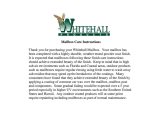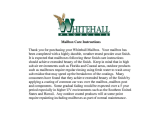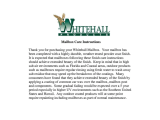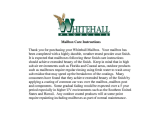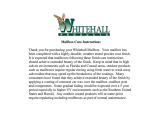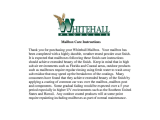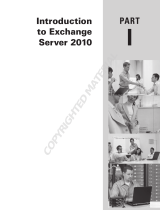Page is loading ...

Microsoft Exchange 2010 on a Hyper-V
Virtual Infrastructure Supported by Dell
EqualLogic SANs
A Dell EqualLogic Best Practices Technical White Paper
Dell Storage Engineering
February 2013
This document has been archived and will no longer be maintained or updated. For more
information go to the Storage Solutions Technical Documents page on Dell TechCenter
or contact support.

2 BP1036 | Microsoft Exchange 2010 on a Hyper-V Virtual Infrastructure Supported by Dell EqualLogic SANs
© 2013 Dell Inc. All Rights Reserved. Dell, the Dell logo, and other Dell names and marks are trademarks of Dell Inc. in
the US and worldwide. Intel® is a registered trademark of Intel Corporation in the U.S. and other countries.
Microsoft®, Windows®, Windows Server®, and Active Directory® are either trademarks or registered trademarks of
Microsoft Corporation in the United States and/or other countries. All other trademarks mentioned herein are the
property of their respective owners.

3 BP1036 | Microsoft Exchange 2010 on a Hyper-V Virtual Infrastructure Supported by Dell EqualLogic SANs
Table of contents
Acknowledgements .......................................................................................................................................................................... 5
Feedback ............................................................................................................................................................................................ 5
Executive summary .......................................................................................................................................................................... 6
1 Introduction ................................................................................................................................................................................ 7
1.1 Purpose and scope ......................................................................................................................................................... 7
1.2 Target audience............................................................................................................................................................... 7
1.3 Terminology ..................................................................................................................................................................... 7
2 Microsoft Exchange and the storage subsystem ................................................................................................................. 9
2.1 Exchange store elements .............................................................................................................................................. 9
2.2 Defining the configuration and deployment variables ........................................................................................... 10
2.3 Considerations for Exchange DAG ............................................................................................................................ 12
3 Test topology and architecture overview ........................................................................................................................... 13
3.1 Functional system design ............................................................................................................................................ 13
3.2 Physical system configuration .................................................................................................................................... 15
3.3 Storage layout ................................................................................................................................................................ 16
4 Trend of Exchange deployment variables ........................................................................................................................... 17
4.1 Characterize the impact of the iSCSI software initiator collocation ................................................................... 19
4.2 Characterize the RAID policy in use .......................................................................................................................... 22
4.3 Database volumes layout ............................................................................................................................................ 25
4.4 Assess the PS6100 family models .............................................................................................................................. 28
4.5 Scale the SAN and the users ....................................................................................................................................... 31
4.6 Exchange 2010 DAG databases activation and operations ................................................................................... 41
5 Best practices recommendations ......................................................................................................................................... 46
A Configuration details ............................................................................................................................................................... 49
A.1 Hardware components ................................................................................................................................................ 49
A.2 Software components .................................................................................................................................................. 50
A.3 Network configuration details .................................................................................................................................... 51
A.4 Host hypervisor and virtual machines configuration .............................................................................................. 54
A.4.1 Host network adapters and Virtual networks configuration ................................................................................. 57
A.4.2 Virtual network adapters configuration .................................................................................................................... 58
B Simulation tools ....................................................................................................................................................................... 59

4 BP1036 | Microsoft Exchange 2010 on a Hyper-V Virtual Infrastructure Supported by Dell EqualLogic SANs
B.1 Microsoft Jetstress considerations ............................................................................................................................ 59
B.2 Microsoft Load Generator considerations............................................................................................................... 60
Additional resources ....................................................................................................................................................................... 62

5 BP1036 | Microsoft Exchange 2010 on a Hyper-V Virtual Infrastructure Supported by Dell EqualLogic SANs
Acknowledgements
This best practice white paper was produced by the following members of the Dell Storage team:
Engineering: Danilo Feroce
Technical Marketing: Jim Salvadore
Editing: Margaret Boeneke
Feedback
We encourage readers of this publication to provide feedback on the quality and usefulness of this
information by sending an email to [email protected].
SISfeedback@Dell.com

6 BP1036 | Microsoft Exchange 2010 on a Hyper-V Virtual Infrastructure Supported by Dell EqualLogic SANs
Executive summary
Virtualization technologies are an optimal answer to address the need to reduce IT operational costs.
These technologies were originally introduced with the aim to consolidate multiple functional services
into a single physical system and to increase hardware utilization. In addition to their basic features, with
additional maturity and growth these platforms now target:
• Enhancing application and services availability
• Agility and simplification of managing complex infrastructures
• Streamlining provisioning of additional resources in rapidly changing environments
• Providing differentiated tactics for disaster recovery and business continuity
This changing ecosystem requires substantial scrutiny of the workload in a virtual infrastructure to
maintain, or widen, the effectiveness of the application when it comes to network or storage planning. A
messaging infrastructure built on Microsoft
®
Exchange has become one of the most critical corporate-
wide services. The 2010 version provides a range of improved capabilities and also the ability to
dramatically expand the mailbox storage repository for end-users via the redesign of its storage access
mechanisms.
This paper answers two important questions: How can the deployment outcomes of the new Exchange
features be planned during the design of a storage subsystem in a virtual infrastructure? How can a system
take advantage of the updated Dell
™
EqualLogic
™
PS6100 Series arrays with the new Exchange 2010
workload?
The deployment variables of the Exchange 2010 mailbox server role were examined and their effect on the
Exchange main performance indicators was evaluated. Some decisive findings of this research are:
• The use of a host iSCSI initiator causes a small efficiency penalty because each storage I/O is
required to cross a greater number of logical layers before reaching the SAN, as opposed to a guest
iSCSI initiator.
• RAID policy analysis shows a small difference in performance in favor of RAID 50 versus RAID 6
during Exchange workloads. The pros and cons evaluation of this type of difference should be
weighed against characteristics such as tolerance to disk failure or available capacity.
• The distribution of user mailboxes with a predefined workload across fewer databases creates the
benefit of a lower overall amount of IOPS performed by the mailbox server. Nevertheless, the
concentration of many users in a single database should be carefully weighed against the
administrative tactics and the data protection measures.
• Each of the PS6100XV 3.5”, PS6100X, and PS6100E models offer a specific combination of disk
performance and available capacity. The selected array should be fitted to the individual workload.
• Scaling the effectiveness of an EqualLogic SAN either up (increasing the user workload) or out
(increasing the number of arrays) always provides linear growth when properly planned.
• The number of DAG nodes and database copies greatly affects the additional workload enforced
during operation activities like seeding or re-seeding of databases.

7 BP1036 | Microsoft Exchange 2010 on a Hyper-V Virtual Infrastructure Supported by Dell EqualLogic SANs
1 Introduction
The EqualLogic PS6100 Series arrays add a heightened capacity and increased overall performance while
preserving the same peer storage architecture, the ease of use and management, the broad out-of-the-
box feature set, and software portfolio as its predecessors. These include scalability without fork-lift
upgrades, native load balancing, point-in-time snapshots, integrated replication, and application layer
software integration and monitoring. The pronounced redesign of Microsoft Exchange 2010 and its
storage functionalities have provided organizations with the opportunity to promote mailboxes with
expanded storage capacity while retaining or improving the previous efficiency and capabilities.
The benefits of a lower Total Cost of Ownership (TCO) with virtualization technologies and private clouds
provides a compelling push for IT departments to innovate their current infrastructures. IT professionals
look forward to the right balance of high availability (HA), reliability and scalability of their virtualized
solutions.
The advantages of these solutions built within a smaller physical footprint, with more efficient and more
granularly managed power consumption and more flexible management under a single pane of glass,
encourage the shift towards consolidated infrastructures powered by blade servers and provisioned by
virtualization technologies.
1.1 Purpose and scope
This white paper describes the results of a study performed to provide guidance and best practices for
deploying Microsoft Exchange Server 2010 on a virtual infrastructure powered by Microsoft Hyper-V
technology and built on Dell PowerEdge
™
blade servers and an EqualLogic SAN. It helps Exchange and
SAN administrators to understand their messaging workload and predict their SAN utilization. The scope of
this paper is restricted to a local datacenter topology and does not include server sizing exercises.
1.2 Target audience
This paper is primarily intended for IT professionals (IT managers, Solution Architects, Exchange and
Storage Administrators, and System and virtualization Engineers) who are involved in defining, planning,
and/or implementing Microsoft Exchange Server infrastructures and who would like to investigate the
benefits of using EqualLogic storage. This document assumes the reader is familiar with Microsoft
Exchange functions, EqualLogic SAN operation, and Microsoft Hyper-V architecture and system
administration.
1.3 Terminology
The following terms will be used throughout this document.
Group: Consists of one or more EqualLogic PS Series arrays connected to an IP network that work
together to provide SAN resources to host servers.
Member: Identifies a single physical EqualLogic array.

8 BP1036 | Microsoft Exchange 2010 on a Hyper-V Virtual Infrastructure Supported by Dell EqualLogic SANs
Pool: A logical collection that each member (array) is assigned to after being added to a group and
contributes its storage space to the entire pool.
Hypervisor: Denotes the software layer that manages the access to the hardware resources, residing
above the hardware, and in between the operating systems running as guests.
Parent and Child Partitions: Identifies the logical units of isolation supported by the Hyper-V hypervisor.
The parent, or root, partition hosts the hypervisor itself and spawns the child partitions where the guest
virtual machines reside.
Virtual Machine (VM): An operating system implemented on a software representation of hardware
resources (processor, memory, storage, network, etc.). VMs are usually identified as guests in relation with
the host operating system that executes the processes to allow them to run over an abstraction layer of
the hardware.
Synthetic drivers: Supported with the Hyper-V technology, these drivers leverage more efficient
communications and data transfer between the virtual and physical hardware, as opposed to legacy
emulated drivers. Synthetic drivers are only supported in newer operating system versions and allow the
guest VMs to become enlightened, or aware, that they run in a virtual environment.
Virtual network: A network consisting of virtual links as opposed to wired or wireless connections
between computing devices. A virtual network is a software implementation similar to a physical switch,
but with different limitations. Microsoft Hyper-V technology implements three types of virtual networks
allowing the connectivity between VMs and devices external to the root host (external), the connectivity
between the VMs and the host only (internal), or the VMs running on a specific host only (private).
VHD: File format for a Virtual Hard Disk in a Windows Hyper-V hypervisor environment.
Non-Uniform Memory Access (NUMA): A multiprocessing architecture in which memory is associated to
each CPU (local memory, accessed faster than memory of other processor) as opposed to SMP where
memory is shared between CPUs.
Microsoft Exchange Database Availability Group (DAG): A pool of networked Exchange mailbox servers
that hosts multiple copies of the same Exchange databases.
Balanced tree (B-Tree): A tree data structure where a node can have a variable number of child nodes,
commonly used in databases to maintain data sorted in a hierarchical arrangement. It allows efficient data
access to the pages for insertion, deletion, and searches.
Process: An instance of a computer program or application that is being executed. It owns a set of private
resources: image or code, memory, handles, security attributes, states, and threads.
Thread: A separate line of execution inside a process with access to the data and resources of the parent
process. It is also the smallest unit of instructions executable by an operating system scheduler.
Key performance indicators (KPI): A set of quantifiable measures or criteria used to define the level of
success of a particular activity.

9 BP1036 | Microsoft Exchange 2010 on a Hyper-V Virtual Infrastructure Supported by Dell EqualLogic SANs
2 Microsoft Exchange and the storage subsystem
Microsoft Exchange Server has a diversified set of components and services that cooperate to support the
disparate requirements to design and deploy a messaging infrastructure within an organization. The
mailbox server role in an Exchange infrastructure has the most impact on storage resources because it
ultimately governs the storage, retrieval, and availability of user data to be routed and presented to the rest
of the infrastructure.
Appropriate sizing of the mailbox role servers is the primary best practice that can prevent performance
bottlenecks and avoid the administrative overhead required to redesign the deployment topology to adapt
to new or changed user requirements. To understand the interaction between the Exchange mailbox
server role and the storage subsystem, the underlying logical components in the hierarchy of Microsoft
Exchange Server 2010 should be examined.
2.1 Exchange store elements
The access to mailbox databases (or public folder databases, when implemented) is the primary element
that generates I/O on a storage subsystem. However, while a database is a logical representation of a
collection of user mailboxes, it is also an aggregation of files on the disk which are accessed and
manipulated by a set of Exchange services (for example, Exchange Information Store, Exchange Search
Indexer, Exchange Replication Service, and Microsoft Exchange server) following a different set of rules.
Database file (*.edb): The container for user mailbox data. Its content, broken into database pages of
32 KB, is primarily read and written in a random fashion as required by the Exchange services running on
the mailbox server role. A database has a 1:1 ratio with its own *.edb database file. The maximum
supported database size in Exchange Server 2010 is 16 TB, where the Microsoft guidelines recommend a
maximum 200 GB database file in a standalone configuration and 2 TB if the database participates in a
replicated DAG environment.
Transaction logs (*.log): The container where all the transactions that occur on the database (create,
modify, delete messages, and others) are recorded. Each database owns a set of logs and keeps a one to
many ratio with them. The logs are written to the disk sequentially, appending the content to the file. The
logs are instead read solely when in a replicated database configuration within a DAG or in the event of a
recovery.
Checkpoint file (*.chk): A container for metadata tracking when the last flush of data from the memory
cache to the database occurred. Its size is limited to 8 KB and, although repeatedly accessed, its overall
amount of I/O is limited and can be ignored. The database keeps a 1:1 ratio with its own checkpoint file
and positions it in the same folder location as the log files.
Search Catalog: A collection of flat files (content index files) built by the Microsoft Search Service, having
several file extensions and residing in the same folder. The client applications connected to Exchange
Server benefit from this catalog by performing faster searches based on indexes instead of full scans.
Microsoft Exchange Server uses a proprietary format called Extensible Storage Engine (ESE) to access,
manipulate, and save data to its own mailbox databases. The same format is now employed on the

10 BP1036 | Microsoft Exchange 2010 on a Hyper-V Virtual Infrastructure Supported by Dell EqualLogic SANs
Exchange HUB server role for the queue databases. ESE technology, previously known as Jet Database
Engine, has evolved through several versions of Exchange Server releases and has been a part of several
Microsoft products since its inception (for example, Microsoft Access, Active Directory, File Replication
Service, WINS server, and Certificate Services).
The ESE is an Indexed Sequential Access Method (ISAM) technology that organizes database data in B-Tree
structures. Ideally, these databases are populated by data kept together or adjacent. When this does not
occur, external reorganization or defragmentation processes should be used to restore the optimal data
contiguity in these structured databases.
For additional information about the Exchange 2010 Store, refer to Microsoft documentation
Understanding the Exchange 2010 Store
, available at: http://technet.microsoft.com/en-
us/library/bb331958.aspx
To summarize, an Exchange mailbox database is subject to a subset of tasks performing storage access:
• The regular read and write access required to retrieve and store user mailbox data (according to the
Exchange cache policy)
• The online defragmentation and compacting activities due to the B-Tree optimization
• The database maintenance, which includes dumpster cleanup, deleted mailboxes purge, and other
activities addressing logical object support
• The checksum database scan to verify data block integrity (sequential read activity), which can be set
to run constantly in the background or at a scheduled time
Furthermore, Exchange Server offers a specialized offline manual defragmentation task that runs while the
database is dismounted by taking advantage of the ESEUTIL.EXE command line tool. The principal goal of
this task is to reclaim the empty space left in a database by online defragmentation and to shrink the size
of the *.edb file itself. This returns the free space to the operating system volume.
Note: It is not recommended to include offline defragmentation in a regular maintenance plan due to the
disruption in the availability of the database, the rupture of the logs chain, and the need for database re-
seeding in case of Database Availability Group configuration.
2.2 Defining the configuration and deployment variables
After determining the I/O activities generated against the storage subsystem for a single database, the
factors that influence the overall I/O footprint of an entire Exchange mailbox server role and the variables
of a deployment should be taken into consideration.
Mailbox usage profiles: Denote the usage characteristics of a mailbox (for example: send, receive, open,
or delete items). They are commonly defined by the amount of messages sent and received per day and
the average message size. It can also be explained in terms of transactional IOPS per mailbox when
considering the size of database cache allocated per mailbox.

11 BP1036 | Microsoft Exchange 2010 on a Hyper-V Virtual Infrastructure Supported by Dell EqualLogic SANs
Mailbox size: Defines the maximum size a mailbox is allowed to grow and can be enforced by a quota
policy. In more general terms, it is the average mailbox size in a corporate messaging environment. It
primarily affects the capacity requirement of a mailbox role server and the planned size of the databases
hosted by the server. Moreover, it influences the IOPS response due to the amount of physical disk surface
that must be accessed to retrieve or store the data.
Number of databases: Designates the database layout and mailbox distribution across the databases. Each
Exchange database is managed as a single administrative unit and is assisted by a set of services with a 1:1
ratio (defragmentation, maintenance, logs generation).
Database and Log placement: Indicates whether the *.edb and log files reside on the same volume or are
deployed on isolated volumes. There are two historical reasons for the requirement to split database and
logs into different volumes (or physical drives):
• Performance: The different I/O pattern of these two streams of data (random reads/writes versus
sequential writes) and the aim to associate them with the most fitting storage device (for example
because of rotational speed or RAID policy).
• Reliability: The simultaneous loss of both the database and logs could jeopardize the recoverability
of user data depending on the data protection tactic in place.
Now, the Exchange Server 2010 I/O footprint reduction, when compared with former versions, lessens the
requirement to split the database and log placement. In addition, the use of a SAN as a storage subsystem
provides different approaches such as EqualLogic Smart Copies to the data protection of the Exchange
mailbox server role that do not require the volume split mentioned above. For additional references refer
to the white paper mentioned in the notes box at the end of this section.
For additional information about Exchange data protection options with Dell EqualLogic SAN refer to the
white paper
Best Practices for Enhancing Microsoft Exchange Server 2010 Data Protection and
Availability using Dell EqualLogic Snapshots
, available at:
http://en.community.dell.com/techcenter/storage/w/wiki/2633.enhancing-microsoft-exchange-server-
2010-data-protection-and-availability-with-equallogic-snapshots-by-sis.aspx
Mailbox count: Represents the number of user mailboxes hosted by the mailbox role server. When the
mailbox count increases, the amount of IOPS, capacity allocated, and logs generated increase.
Furthermore, when a large number of mailboxes are hosted by a single server, this intensifies the demand
for a highly available solution due to the risk of widely distributed loss of service in a messaging
organization.
High availability footprint: Refers to the overhead of having a highly available solution in place with data
replication involved. See Section 2.3.
Data protection footprint: Identifies the planned amount of IOPS used by the solution that protects the
mailbox database data. Since a customized solution is usually tailored to each distinct production
environment (for example 24x7, or 9 to 5) the impact is greatly variable and depends upon the degree of
parallelism between the regular data access and the data protection access.

12 BP1036 | Microsoft Exchange 2010 on a Hyper-V Virtual Infrastructure Supported by Dell EqualLogic SANs
2.3 Considerations for Exchange DAG
A DAG is a pool of up to 16 networked servers that hosts multiple copies of the same Exchange database
or databases where only one of the copies is active at a specific point-in-time within the group. The other
copies are passive and contain data sourced from replicated and replayed transaction logs. When DAG is
implemented, it creates some deviations in the storage access patterns and in the Exchange memory
cache behavior.
Transaction Logs access when using DAG configuration adds to the conventional sequential write pattern
a sequential read access pattern required to perform the replication activities.
Log Checkpoint depth refers to the amount of logs written to the disk and that contain transactions not
yet flushed to the database file. It is usually set at 20 in a standalone server installation and is increased to
100 when implementing a DAG configuration. This change reduces the write I/O for the given database
because user activity changes are combined in memory (coalescing), and thus the overall I/O is reduced.

13 BP1036 | Microsoft Exchange 2010 on a Hyper-V Virtual Infrastructure Supported by Dell EqualLogic SANs
3 Test topology and architecture overview
This paper presents a set of findings from tests conducted on a Microsoft Windows infrastructure and an
Exchange organization built on Windows Server with Hyper-V technology accessing storage resources
provided by an EqualLogic SAN. Multiple simulation tools, both Microsoft Jetstress and Loadgen, were
used to generate the workloads required for this study.
The architecture deployed consists of two different sets of components residing within the same topology
and able to support either the servers running the Jetstress simulated mailbox servers or the complete
messaging services required to run a medium-sized organization (up to 5,000 users).
3.1 Functional system design
The functional elements for the infrastructure supporting the Jetstress-based tests are shown in Figure 1.
Figure 1 Functional system design for Jetstress tests

14 BP1036 | Microsoft Exchange 2010 on a Hyper-V Virtual Infrastructure Supported by Dell EqualLogic SANs
The main elements of the design are:
• Single Active Directory forest, single domain, single site (not strictly required for the tests)
• Centralized management and monitoring with dedicated resources
• Building block design approach for mailbox role servers with Jetstress
• Separated network design for traffic isolation between LAN and iSCSI
The architecture has then been modified to include the additional elements required to support the
complexity of an Exchange organization deployed with highly available building blocks, as shown in Figure
2.
Figure 2 Functional system design for Exchange Server tests
Additional components include:
• Redundant HUB transport server services and resilient Client Access servers (load balanced)
• Mailbox database servers participating in a DAG for HA and resiliency
• Dedicated resources for client-side simulation with the Exchange Loadgen tool

15 BP1036 | Microsoft Exchange 2010 on a Hyper-V Virtual Infrastructure Supported by Dell EqualLogic SANs
3.2 Physical system configuration
The physical components of the test infrastructure were configured as show in Figure 3.
Figure 3 Physical system design
The solution is deployed on Dell Blade servers with the aim of a greater datacenter density and flexibility.
The main components of the physical deployment are:
• Single M1000E Blade enclosure with redundant chassis management controllers (CMC) and fully
populated power supplies configured for redundancy

16 BP1036 | Microsoft Exchange 2010 on a Hyper-V Virtual Infrastructure Supported by Dell EqualLogic SANs
• Single EqualLogic iSCSI SAN provisioned with one of the following array models (exchanged for
each test): PS6100 3.5”, PS6100X, or PS6100E
• Single EqualLogic iSCSI SAN with up to three PS6100XV 3.5” arrays for the test to scale out the SAN
to multiple arrays or to support multiple data copies of the DAG nodes
• Dual PowerConnect M6220 Ethernet switches (stacked) to support LAN IP traffic (Fabric A)
• Dual PowerConnect M6348 Ethernet switches (vertically stacked in pairs with the PC7048R
switches) to support the iSCSI data storage traffic on the server side (Fabric B)
• Dual PowerConnect 7048R Ethernet switches (vertically stacked in pairs with the M6348) to support
the iSCSI data storage traffic on the SAN side
• Link Aggregation Group (LAG) consisting of four fibre connections (two from each switch) between
the Fabric B M6348s and the top of rack (ToR) PC7048R switches in a mesh pattern
Note: More details of the test configuration, including a hardware and software list, SAN array
characteristics, hypervisor and VMs relationship, network connections, and blade switch fabric paths are
provided in Appendix A.
3.3 Storage layout
The EqualLogic SAN arrays and the volumes underlying the Exchange databases are configured with:
• One EqualLogic group configured with one unit of each array model (exchanged for each test):
PS6100 3.5”, PS6100X, or PS6100E.
• One EqualLogic group configured with one to three array members for the simulation to scale the
SAN to multiple arrays.
• One storage pool defined within the group that includes the single member or all the members of
the group for the test case of multiple arrays.
• The RAID policy specified as part of each test case.
• Five volumes created in the pool, unless specified in the test case. One volume dedicated to each
Exchange mailbox database and a set of log files with a 1:1 ratio.
Figure 4 reflects the common volume layout implemented on the EqualLogic SAN.
Figure 4 Storage layout

17 BP1036 | Microsoft Exchange 2010 on a Hyper-V Virtual Infrastructure Supported by Dell EqualLogic SANs
4 Trend of Exchange deployment variables
The performance trends of an EqualLogic SAN and of the Hyper-V virtual infrastructure were evaluated
under the load of a simulated Exchange mailbox role server. The following sections summarize each of
the variations tested to understand these trends.
To forecast the storage requirements of a present or future deployment, begin with the analysis of the
topics listed below:
• Define an average usage profile for a mailbox user in the organization
• Define the mailbox quota or cap the organization plans to enforce
• Average mailbox count per database planned for the deployment
• HA options to be considered for the mailbox service (DAG) and their workload overhead
• Collocation of mailbox database files on the SAN and methodology to access them (initiators)
• Disks failure tolerance, available capacity, and performance of the RAID policy selected
• Storage capacity and performance of the array model selected against the Exchange type workload
• Number of users per deployment building block and space for future growth
• Horizontal scalability of the SAN and the virtual infrastructure
The reference Exchange mailbox server role configuration used is detailed in Table 1. For each test
completed, a description of the variations applied to this reference baseline is provided in each section.

18 BP1036 | Microsoft Exchange 2010 on a Hyper-V Virtual Infrastructure Supported by Dell EqualLogic SANs
Table 1 Reference configuration for Microsoft Jetstress 2010 tests
Reference configuration: Test variables under study
Number of simulated mailboxes/users
5000 concurrent users
Number of databases
5 databases (active)
Mailbox allocation
1000 mailboxes per each mailbox database
Database size
1TB each
RAID policy
RAID 6
iSCSI initiator software collocation
Guest initiator (residing in the VMs)
Number of units, Array model, SAN configuration
1x PS6100XV 3.5”, one single pool (default)
Reference configuration: Consistent factors across each test
Messages per day per mailbox / IOPS per mailbox
200 messages / 0.20 IOPS (with DAG)
Mailbox size
1GB each
Number of database replica copies
2 (2 node DAG)
Background database maintenance
Enabled
Windows Disk/Partition, File System
Basic disk, GPT partition, default alignment
NTFS, 64KB allocation unit size
Test duration
2 hours + time required to end DB checksum (for
Jetstress based tests)
Below is a list of metrics and pass/fail criteria recorded while completing the tests. Most of this information
is outlined by the Jetstress tool or is verified through Windows Performance Counters and Dell EqualLogic
SAN Headquarters while a Jetstress or Loadgen simulation is running. Microsoft data around thresholds for
storage validation are reported as well.
Database Reads Average Latency (msec) is the average length in time to wait for a database read
operation (random reads). It should be less than 20 milliseconds according to Microsoft threshold criteria.
Database Writes Average Latency (msec) is the average length in time to wait for a database write
operation (random writes). It should be less than 20 milliseconds according to Microsoft threshold criteria.
Logs Writes Average Latency (msec) is the average length in time to wait for a log file write operation
(sequential writes). It should be less than 10 milliseconds according to Microsoft threshold criteria.
Planned Transactional IOPS are the target amount of IOPS for the test (calculated by multiplying the
number of users by the IOPS per mailbox).

19 BP1036 | Microsoft Exchange 2010 on a Hyper-V Virtual Infrastructure Supported by Dell EqualLogic SANs
Achieved Transactional IOPS are the amount of IOPS actually performed by the storage subsystem to
address the transactional requests. The result should not diverge more than 5% from the planned IOPS to
be considered a successful test iteration according to Microsoft Jetstress.
LOGs IOPS are the IOPS performed against the log files during the transactional test. They are not directly
taken into account as part of the transactional IOPS, but tracked separately instead.
Differential IOPS are the IOPS generated for the DB maintenance and all the remaining activities on the
storage subsystem, calculated as the difference between the IOPS provisioned by the EqualLogic SAN and
the previously reported transactional and logs IOPS.
Total IOPS of the SAN is the sum of the three elements above: achieved transactional IOPS, Logs IOPS
and differential IOPS. It represents the entire IOPS footprint performed against the back-end SAN during a
test. It is recorded at the SAN level and verified with the Exchange host.
Note: For details about the simulation tools, Microsoft Jetstress and Loadgen 2010, refer to Appendix B.
4.1 Characterize the impact of the iSCSI software initiator collocation
The goal of the initial iSCSI initiator type analysis was to establish the Exchange KPI trend, IOPS ratios, and
their relationship when using two different collocations for the iSCSI software initiator enabling the access
to the SAN volumes, while maintaining the other factors. Table 2 shows the configuration parameters for
this test.
Table 2 Test parameters: iSCSI software initiator collocation
Reference configuration: Test variables under study
iSCSI initiator software collocation
Host initiator (residing in the Hyper-V root)
or
Guest initiator (residing in the VMs)
Reference configuration: Consistent factors across this test
Messages per day per mailbox / IOPS per mailbox
200 messages / 0.20 IOPS (with DAG)
Number of simulated mailboxes/users
5,000 concurrent users
Number of databases
5 databases (active)
Mailbox allocation 1,000 mailboxes per each mailbox database
Mailbox size
1GB each
Database size
1TB each
Number of database replica copies
2 (2 node DAG)
RAID policy
RAID 6
Number of units, Array model, SAN configuration
1x PS6100XV 3.5”, one single pool (default)

20 BP1036 | Microsoft Exchange 2010 on a Hyper-V Virtual Infrastructure Supported by Dell EqualLogic SANs
In a typical iSCSI based SAN, the initiator is regarded as the client which is accessing the storage resources
located on an iSCSI server, or target, by sending SCSI commands over an IP network. The initiator falls into
two broad types: software initiator (software implementation installed within the operating system running
the initiator) or hardware initiator (a dedicated hardware resource, most commonly a host bus adapter).
In the infrastructure built for our tests we used software initiators only, provided natively by Windows
Server 2008 R2 and integrated by the EqualLogic Host Integration Tool Kit. The two configurations
validated are based on a different collocation of the software initiator.
1. Guest initiator: software located and running on the guest VMs, which allows you to directly
connect to the volumes residing on the EqualLogic SAN from the virtual network adapters of the
guest. The settings of the VMs include four additional virtual network adapters dedicated to SAN
traffic. The host hypervisor is not aware of the type of traffic traversing the VMBus adapters.
2. Host initiator: software located and running on the host hypervisor, which allows you to connect
to the volumes residing on the EqualLogic SAN from the root partition of Hyper-V through four
physical network adapters dedicated to the SAN traffic. VHD fixed-sized files are created on each
of the SAN volumes attached to the host and then added as SCSI disks to the settings of the VMs.
The VMs are not aware of where their disks reside, either on local storage or the SAN.
Figure 5 shows the results collected from the Exchange Jetstress simulations of the two different iSCSI
initiator collocations.
/
